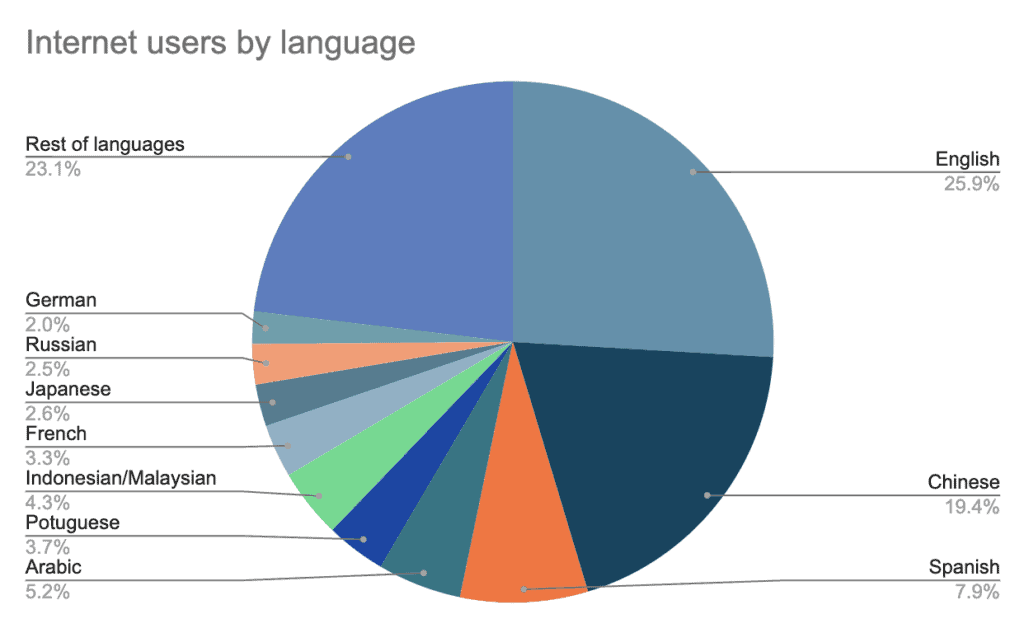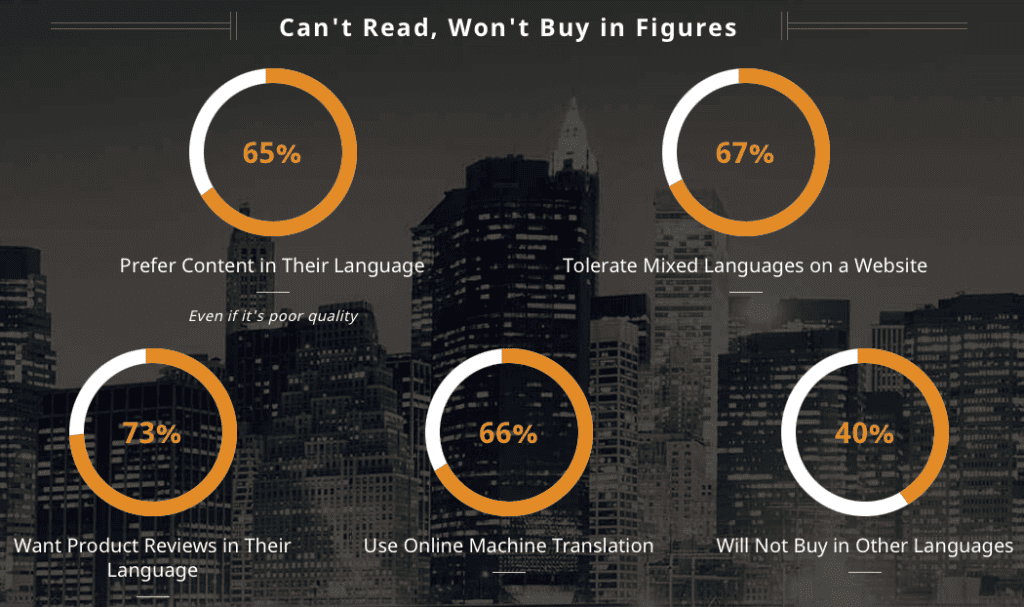

This blog post is made up of material from the first two lessons of the Product Localization for UX course by Patricia Gómez Jurado. If you enjoy this sample, enroll as an individual or a team today!
Take a look at this 8-minute video from web developer and educator Tom Scott about why getting translation & localization (T&L) right is so difficult. Tom illustrates the careful balance teams must strike between language, design, and development.
As Tom explains, globalization has accelerated the need to make digital content accessible in multiple languages for different countries, regions, and cultures.
Regardless of the size of the organization you work for, localization and translation are key parts of any growth or expansion strategy.
If there is no localization team in your company, you might be tasked with leading a translation project at some point in your career, particularly if your company is looking at expanding to international markets.
But why are T&L so important?
The world we live in is diverse and multilingual. English might be the common language in business environments, but that‘s not true everywhere on the internet. In fact, English-language users make up only about 26% of internet users.
According to Internet World Stats the other 9 top languages are Chinese (traditional and simplified), Spanish (in all its variants), Arabic, Portuguese (from Brazil and Portugal), Indonesian/Malaysian, French, Japanese, Russian and German.*
*Note: We’re talking here about written languages, not “languages.” The traditional / simplified Chinese distinction is one of written language and does not exist as an oral language difference—regional languages and dialects do, of course but that’s a different story.

In 2020, content and language services firm CSA Research published ”Can‘t Read, Won‘t Buy” summarizing people‘s attitudes towards using products in their own language versus other languages.
CSA surveyed 8,709 consumers in 29 countries and the results were eye-opening, although perhaps not as surprising to someone who works in content:

Considering these insights, you can see how important good translation is to increasing international revenue—and for usability in general. Users show a strong preference for reading and interacting in their primary language.
As a UX writer, you already know how the words we read impact how we think and feel. Not only is it important to create product content that guides the user, but you also want to create trust.
Language is important here. You can create trust by:
By speaking in a consistent brand voice, consumers will get to know you as a company. And when they feel like they know you and can trust you, they are more likely to buy from you. Later down the road, they’re more likely to become brand loyalists or promoters. That’s the intended outcome.
With a solid UX content strategy in place where you’re able to stick to the same tone of voice and use of terminology, you’re in a perfect position to build great customer relationships through your interface writing.
Content strategy should not only focus on the source language but include the languages you localize to as well.
A typo or a grammatical error might not seem like a big deal, but your users could interpret this as a signal that your company doesn’t care enough to be accurate.
If you’ve got these kinds of errors in your product, what other bugs or errors do you have? Research shows that consumers are more likely to leave a website that has typos in it.
This is as true for source content as it is for translated and localized content.
Alrighty, let‘s get grounded in some concepts and definitions we’ll use throughout the course. You might have noticed our shorthand use of “T&L” instead of “translation and localization.” Get comfortable with that one since you’ll see it a lot.
Now, a brief and simplified overview of our terms.
Many writers and designers use the terms ”translation” and ”localization” interchangeably. But they‘re pretty different! Each requires a separate process to adapt a product for a new audience.
Let‘s define our terms:
To simplify this even further, translation is focused on adapting the words and messages into another language.
Localization is the process of retrofitting the visual and interactive elements of the design to fit the cultural context of how those elements function in a different culture.
Getting translation right can help you avoid unintentional mistakes. For example, when Pepsi expanded their market to China, they launched with the slogan:
What they didn’t realize is that the phrase literally translated to:
To us this may seem funny, but it was a blow to Pepsi’s global brand.
When we talk about localization, we describe a much broader practice. It’s about how different cultural norms can be misinterpreted if not applied correctly. For example, take a look at this HSBC advertisement from 2002 that demonstrates the importance of localization when operating in countries outside your headquarters.
T&L are interlinked, particularly when it comes to designing and shipping software.
For example, say that you have created and launched a Portuguese-language app in Brazil, and you would like to translate the words into English to sell your app in the UK.
Translating the words is straightforward, but localization is complex. We need to consider several factors:
This is where localization comes in.
Localization is the holistic incorporation of languages and customs into products and experiences. Changes to the source materials might be required because of different technologies, standards or laws, locally-dominant third-party apps, cultural and religious propriety, or regional conventions.
As Nataly Kelly, VP of localization at Hubspot (and author of the born to be global blog) describes it, localization is all about ”creating a local, and delightful, end-to-end customer experience.”
Simple, right? If only.
In addition to T&L, we need to understand 2 more terms.
In Tom Scott’s video from lesson 1, he described the process of internationalization.
Lastly, global companies need to operate using a globalization framework to be successful.
These decisions will be different for every organization, but to figure out what works for you, let’s take a look at a helpful comparison from Nataly Kelly in born to be global.
| Process | What gets adapted |
|---|---|
| Translation | Message |
| Localization | Experience |
| Internationalization | Code |
| Globalization | Framework |
Once you‘ve split out the process from things that need localizing, you can use success criteria like these to assess the impact of your work:
| Process | Success |
|---|---|
| Translation | Our message resonates in other markets. |
| Localization | Our customer experience delights in other markets. |
| Internationalization | Our code works in other markets. |
| Globalization | Our framework solves for other markets. |
Localization adapts the experience to the local audience. But what does that mean? Depending on the country you‘re launching in, some aspects of a product will need to be changed, while others will remain the same.
As products and services become more global, this process becomes standard for product teams.
Pixar‘s work for the movie Inside Out is a good example of globalization in action. In the movie, the main character is a kid named Riley who is working on managing her emotions. Her dad spends a lot of time imagining sports. The sport played in his head was changed from American hockey to soccer (football) to make the scene more relatable for international audiences.
In total, 28 graphics across 45 different shots were localized for individual markets.

Note: If you’re interested in film localization, you can watch the Disney+ release Inside Pixar, a documentary series featuring the work involved in making Inside Out. Or you can watch this 7-minute video on how 10 Pixar movie scenes were changed in other countries.
How does localization apply to products in other sectors? Think about the number of differences that exist just in the fintech space:
Those differences add up to a significant need for redesigning software post-translation. The localization process reminds us that launching products in new global markets involves design beyond the words themselves.
ASOS, a British online fashion retailer, is a perfect example of a successfully localized ecommerce platform. They offer 10 different payment methods, accept 19 currencies, and enable users to set their experience preference by both language and region. Those preferences set the language, display different product offers, and change payment options.

In the early 2010s, Intuit decided to explore offering QuickBooks products to English-speaking users in India.
It seemed like a clear, straightforward business decision to localize QuickBooks for US English speakers to QuickBooks for Indian English speakers. The accounting principles in both countries were similar, and math is math. But when the product team started on the project, they discovered it was more complicated than expected.
Prior to 2018, business owners in India often kept 2 sets of books for accounting purposes: 1 for the government to see, and 1 that showed the ”real” cost of doing business, including “off-book” payments and bribes to officials.
Small business owners in India had no use for accounting software that only kept half of the records they needed—and they certainly did not want electronic records of the other half.
Intuit had to delay any plans for releasing a product in India until they’d done much more thorough local and cultural research.

Before undertaking an international project, an executive with decision-making authority, usually someone from the product or marketing teams, needs to:
It makes sense that companies would want to take advantage of T&L to essentially re-deploy a successful product in an entirely new market. But companies must also understand whether their product is necessary and appropriate for the new language, culture, and ways people do business in the new market.
Investing in tools, people, and processes is critical to ensure quality translations and a delightful user experience.
Get our weekly Dash newsletter packed with links, regular updates with resources, discounts, and more.
